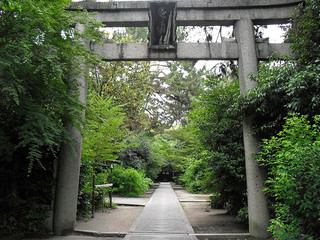Difference between revisions of "Nashinoki Shrine"
(Created page with "right|thumb|320px|The main [[torii at Nashinoki Shrine, with the shrine grounds themselves in the background]] *''Established: 1885'' *''Japanese'':...") |
m (location) |
||
| Line 14: | Line 14: | ||
*Plaques on-site. | *Plaques on-site. | ||
<references/> | <references/> | ||
| + | |||
| + | ==External Links== | ||
| + | *[https://maps.google.com/maps?q=%E6%A2%A8%E6%9C%A8%E7%A5%9E%E7%A4%BE&hl=en&ie=UTF8&ll=35.02339,135.767498&spn=0.074927,0.169086&sll=35.449344,139.636402&sspn=0.075094,0.169086&t=h&hq=%E6%A2%A8%E6%9C%A8%E7%A5%9E%E7%A4%BE&radius=15000&z=13&layer=c&cbll=35.023255,135.767529&panoid=_7vC_j5DlCpDYkolcuVaLQ&cbp=12,327.52,,0,4.88 Nashinoki Shrine on Google Maps] | ||
[[Category:Shrines]] | [[Category:Shrines]] | ||
[[Category:Meiji Period]] | [[Category:Meiji Period]] | ||
Latest revision as of 12:46, 27 August 2013

- Established: 1885
- Japanese: 梨木神社 (Nashinoki jinja)
Nashinoki Shrine is a Shinto shrine immediately adjacent to the Kyoto Imperial Palace, established in 1885 and dedicated in 1915 to the spirits of court nobles Sanjô Sanetsumu and his son Sanetomi, in recognition of their great service to the Imperial institution. The shrine is known for its bush clover (hagi) and attracts many visitors during the annual Hagi Festival in mid-to-late September.
Sanjô Sanetsumu served three emperors over the course of a 47-year career, from 1812 until his death in 1859; due to his role in reviving, to some extent, the activity and power of the Imperial institution, he attracted the ire of the Tokugawa shogunate, and spent his last year in seclusion at the temple Ichijô-ji, keeping his head down. Following his death in 1859, the Court granted him the posthumous name chûseikô (roughly, "loyal and sincere lord").
His son played an active and prominent role in the sonnô jôi ("Revere the Emperor, Expel the Barbrians") movement during the Bakumatsu Period, and was rewarded for his service by the Meiji government, which appointed him the first daijô daijin of the modern era, in 1871. Following his death twenty years later, he was posthumously granted the top court rank, that of Senior First Rank (正一位).
The shrine is named after the town of Nashinoki, where the Sanjô family maintained a mansion. It contains an old tearoom which previously belonged to the Shinsenden of the Shunkôden of the Imperial Palace; the well at the shrine, known as Somei, is famous as well, the only one of "the three wells" of Kyoto to have not dried up.[1]
References
- Plaques on-site.
- ↑ The three wells are Somei 染井, Agatai (県井) and Samegai (醒ヶ井).